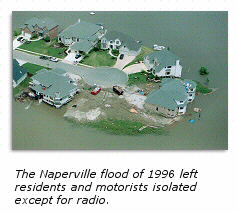|
|
|
|
|
|
|
|
| DHS'
Customs & Border Protection Deploys First National
Information Radio Network |
|
 WASHINGTON,
DC: US
Customs and Border Protection (CBP) can motorists entering
the USA exactly what they need to know, for example: WASHINGTON,
DC: US
Customs and Border Protection (CBP) can motorists entering
the USA exactly what they need to know, for example:
* Is the crossing open?
* How long is the wait?
* Which lane should I be in?
* What documents do I need?
Because the CBP is installing a special information radio
station, referred to as a Travelers Information
Station/Highway Advisory Radio (TIS/HAR) system, at key land
border ports of entry, providing information to approaching
motorists with the intention of expediting their passage
across the border.
The federally licensed 10-watt AM radio stations are
currently installed in El Paso, Laredo, TX; San Luis, AZ;
and Calexico (East), CA. Additional sites are planned on the
southwest border and locations on the US/Canadian border are
also being considered.
The stations provide the capability of broadcasting
time-sensitive messages developed at the local ports of
entry, in addition to messages developed at the national
level by CBP Headquarters.
Project manager Daniel Piscopo states that the broadcast
messages will include “how to use high-tech travel cards,
information about CBP's Trusted Traveler Programs, basic
border crossing rules and regulations, emergency travel
information and
updates, and border wait times.”
Results of a pilot survey conducted by CBP at El Paso,
Texas, indicate that there is considerable awareness and
favorability regarding use of the radio stations, and
agreement that they would be especially valuable as a tool
to gauge wait times.
CBP will be able to communicate directly to travelers about
how to expedite their border crossing, for example, by
broadcasting information about CBP programs such as the
Ready Lane — an expedited travel lane for people with radio
frequency identification technology enabled cards -- and
Trusted Traveler lanes for pre-approved, low-risk travelers.
Radio broadcasts can be heard for several miles around the
port, giving CBP the ability to provide necessary
information to travelers as they approach the border.
Perhaps someday it will be common practice for motorists to
reach for their radios as they reach the US.
|
|
back to top |
|
Information Stations for California Wildfire Evacuations |
|
 MONTECITO, CA: Two significant wildfires in three
weeks near Santa Barbara, California, have tested the area’s
Information Radio Stations’ ability to direct the public
quickly out of harm’s way. MONTECITO, CA: Two significant wildfires in three
weeks near Santa Barbara, California, have tested the area’s
Information Radio Stations’ ability to direct the public
quickly out of harm’s way.
On October 17th, a vegetation fire caused by downed power
lines required the evacuation of Painted Cave, CA – a
community that lost more than 400 homes and public buildings
in a devastating fire in 1990. The nearby San Marcos Pass
Information Station on AM 1040, operated by Mike Williams,
broadcast critical fire and evacuation information
continuously for residents as they lined up on Highway 154
to exit. In the end, all lives and structures were saved and
the fire was contained to 44 acres.
Three weeks later, a similar fire in Montecito,
California's, backcountry triggered emergency evacuation
information to be broadcast on Montecito Fire Protection
District’s Information Station on AM 1610. The San Marcos
Pass station carried the evacuation information, as well.
Fortunately, this fire was contained by late afternoon and
residents returned to intact homes.
States Williams, “The use of low power radio in emergency
situations proves invaluable. The ability to provide quick
information to the public is essential during fast moving
events such as wildfires.”
In addition to Montecito’s radio station, the greater Santa
Barbara region hosts a cluster of stations operated by UC
Santa Barbara, Wildland Residents Association, and Santa
Barbara County Emergency Management Agency.
|
|
back to top |
| Lexington-Fayette Urban County Government |
|
LEXINGTON, KY:
Lexington/Fayette County Urban County Government provides
services to a population of approximately 300,000 persons
(not including transient student and medical patient
populations) over an area of 286 square miles. There are
more than 1,100 lane miles of highways in the county,
including portions of Interstate 75 and Interstate 64, US
highways 25, 27, 60, 68, 421 and state highway 4 (New Circle
Road) which runs a loop around the county approximately 6
miles from the center of the downtown area. Additionally,
Man O’ War Boulevard extends a half-loop through the
southern edge of the county.
Lexington/Fayette County is home to three major colleges and
universities, several large regional shopping centers, six
hospital complexes, including two Veterans Administration
facilities and local, federal and state prisons. Lexington
is also home to two horse racing facilities, a regional
airport and dozens of small, 15px and large manufacturing
and professional service businesses.
It is important to note that I-75 and I-64 merge in Fayette
County. These interstate highways provide a major
north-south and east-west passenger car and semi-trailer
truck route through the United States. On an average day,
more than 90,000 vehicles travel these interstate highways.
It is also of importance that while not necessarily in
Fayette County, several military installations of importance
exist within 10 miles of the county border. The most
significant installation is the Bluegrass Army Depot, the
location of the largest stockpile of chemical weapons still
remaining in the United States. Lexington/Fayette County is
a designated host community which means that it will serve
as a medical service provider and evacuation site should
there be an accident at the depot involving the chemical
weapons. Other facilities provide logistics, repair,
re-supply and transportation responsibilities. All
facilities provide support for worldwide peacekeeping,
intelligence and training missions.
The current TIS system is used to provide life safety
information to the public in case of emergency and other
information within the current administrative definitions.
Given the nature of the traffic flows, the population,
fast-changing weather conditions and the nature of military
installations in nearby counties, it is vital that the
Lexington-Fayette County Division of Emergency Management
have the means and capabilities of communicating to the
motoring public.
These messages are intended not only to communicate
emergency response information that is in direct response to
an accident, incident or natural disaster but also to
communicate awareness and preparedness messages to the
motoring public that travels through the county.
It is critical that the Division of Emergency Management be
able to broadcast important life safety and preparedness
messages to the resident and transient populations when the
highly trained and skilled professionals in the division
determine it to be appropriate. Broadcasting messages that
could save lives and prevent future loss of life and
property damage should not be limited to the narrow
definition currently found in the TIS regulations.
The Lexington-Fayette County TIS system has been used to
provide information to motorists in the case of severe
weather. The best and most timely source of this
information, as well as all-hazard emergency information is
the NOAA Weather Radio network, provided by the federal
government’s Department of Commerce.
Patricia Dugger
Emergency Management Director
|
|
back to top |
| Naperville
Emergency Managment |
|
 NAPERVILLE,
IL: During my employment in Naperville I became
aware of the Travelers Information Radio Service (TIS) and,
after researching this system, decided that it fit perfectly
into our emergency preparedness plans. Naperville (located
in the tornado alley of Illinois) has an extensive emergency
management program, including 25 outdoor warning sirens,
alert radios in all schools and city buildings, emergency
override on both cable TV systems and a pager system to
alert hearing-impaired residents (the City pays cost of
pager). Backing up this system is a volunteer program whose
members are trained in emergency response and weather
watching. The City has an Emergency Operations Centers (EOC)
that is fully equipped with weather monitoring equipment,
emergency radio systems and amateur radio equipment. The TIS
system added a new tool to keep area motorists informed
daily of any emergency as well as day-to-day information
relative to the City of Naperville. NAPERVILLE,
IL: During my employment in Naperville I became
aware of the Travelers Information Radio Service (TIS) and,
after researching this system, decided that it fit perfectly
into our emergency preparedness plans. Naperville (located
in the tornado alley of Illinois) has an extensive emergency
management program, including 25 outdoor warning sirens,
alert radios in all schools and city buildings, emergency
override on both cable TV systems and a pager system to
alert hearing-impaired residents (the City pays cost of
pager). Backing up this system is a volunteer program whose
members are trained in emergency response and weather
watching. The City has an Emergency Operations Centers (EOC)
that is fully equipped with weather monitoring equipment,
emergency radio systems and amateur radio equipment. The TIS
system added a new tool to keep area motorists informed
daily of any emergency as well as day-to-day information
relative to the City of Naperville.
Naperville experienced a citywide flood incident in 1996
that taxed the emergency response plan. Over 10,000 homes
experienced some level of flooding, residents were moved to
emergency shelters, streets were underwater, including an
overpass, cable TV was out and there were power outages. We
were not able to provide any information to our residents
until the cable TV came back on line with the exception of
using the TIS to provide road and traffic information. In
reviewing our response to this disaster, it was noted that
we needed a system to keep the motorists informed and the
Travelers Information Station was the answer.
The TIS station proved to be a most valuable tool. We
programmed into the station system emergency weather
announcements for tornado warnings thus enabling drivers to
seek shelter as a storm approached. We had several heavy and
crippling snow storms during the winters and the station
provided information to residents on what roads were closed
and when areas would be plowed. On a day-to-day basis, the
station has been used to provide information on emergency
road closures and any imminent safety information the City
felt necessary to quickly deliver to people who were
driving.
As a Regional President for the International Association of
Emergency Managers (IAEM) I have shared our various programs
for alerting and keeping local motorists informed on a day
to day basis and in times of emergency. The Travelers
Information Station was always first on my list.
UPDATE: The City later authorized a complete rebuild of
their Information Station system, upgrading to RF-based
Wireless Audio Link as the means of audio distribution
to the synchronized (2) stations; program control via ISS’s
IP76 (file/network based) message repetition system;
adding the
InfoRadio Format to increase professional sound and
providing the programming to residents via
StreamCAST to PC’s and portable devices. Naperville is
retaining
NOAA Weather Radio emergency interrupts as well as their
phone-based audio system as a redundancy.
Bill Reynolds
Naperville Fire Department
|
|
|



